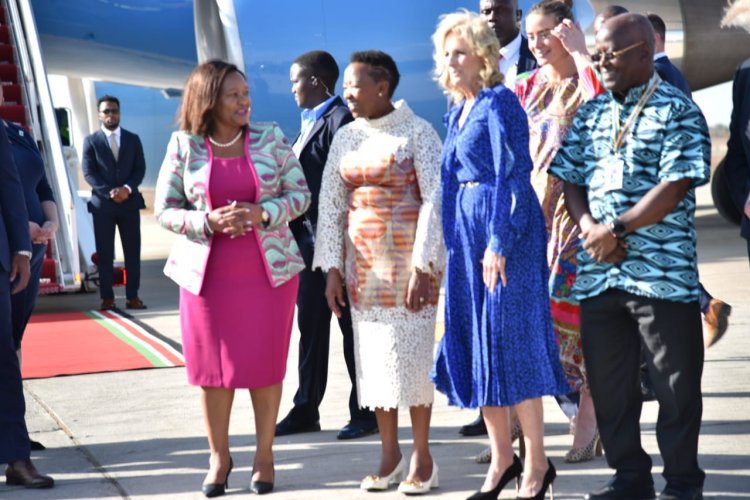Waiting In Plane For Long- Secret Service Measures In Jill Biden's Kenya Visit
Some Kenyans may have noticed that Dr Biden stayed in the Air Force 2 aircraft for...

Amidst the fanfare that greeted First Lady of the United States (US), Dr Jill Biden when she landed in Kenya on Friday, February 24, a number of security protocols were in place for Very Very Important Persons (VVIP) landing at the Jomo Kenyatta International Airport (JKIA) in Nairobi.
Some Kenyans may have noticed that Dr Biden stayed in the Air Force 2 aircraft for several minutes before she disembarked and greeted government officials, including her Kenyan counterpart, Mama Rachel Ruto.
Also accompanying Mama Rachel was Hon. Rebecca Miano, the Cabinet Secretary, East African Community (EAC), Arid and Semi-Arid Lands (ASALs), and Regional Development. Dr Biden later proceeded to State House Nairobi to meet with Mama Rachel in private.
The reason Dr Biden stayed inside the aircraft for a few minutes was so that her security could sweep the area, scanning for potential threats. This is one of the measures usually taken by the US Secret Service which accompanied her to Kenya.

US First Lady, Jill Biden meets First Lady Rachel Ruto after landing at JKIA on February 24, 2023. /FACEBOOK
According to the Federal Aviation Administration (FAA), an advance survey group comprised of representatives of the Office of the Military Assistant to the President, the U.S. Secret Service (USSS), the White House Staff, and a Presidential Advance Agent may visit each Air Traffic Control (ATC) facility the Presidential aircraft will transit prior to its arrival.
The visit is normally made several days in advance of the trip to determine security aspects and the availability of supporting services.
On this visit, the group may meet with the airport operator, the Air Traffic Manager (ATM), and other interested parties. Based on the evaluation by this group, a decision is made on the use of the airport, and further coordination is planned for the advanced group.
The advance group, comprised of representatives of the same organizations as aforementioned, will meet with the same airport elements to complete security measures and supporting services and determine the necessary restrictions to air traffic operations before the arrival and departure of the Presidential aircraft and while the Presidential entourage is on the airport.
The security provisions may include stationing a guard in the tower cab or at the tower entrance and maintaining two-way communications between the control tower and agents on the ground.
This meeting will be held several days in advance of the planned arrival of the Presidential aircraft. The advance group has been requested to have all elements of the group coordinate with the FAA simultaneously.
The ATM must appoint an air traffic supervisor to serve as a coordinator who will be responsible for attending all meetings and briefing all affected personnel. Additionally, the coordinator must brief the Air Traffic Control System Command Centre (ATCSCC), the appropriate Air Route Traffic Control Centre (ARTCC), and other affected ATC facilities within their jurisdiction of any traffic delays or restrictions.
All advance coordination must be documented, with special attention given to routes, radio frequencies, and assigned transponder codes. This documentation must be made available to the personnel on duty who will be handling the Presidential movement.
The meeting must be attended by the ATM, the coordinator, and, if available, the supervisory specialist(s) who will be on duty and directly involved in the control of airport traffic during the arrival and departure, and while the Presidential entourage is on the airport.
The ATM must take whatever steps are necessary to ensure that the Presidential flight, Presidential support aircraft, and entourage are given priority. Restrictions will be placed upon normal air traffic operations to provide priority unless directed otherwise by the Domestic Events Network (DEN) Air Traffic Security Coordinator (ATSC). Air traffic personnel must be guided by the determinations of the advance group and must cooperate to the maximum extent possible.
The ATM must also consider the following measures:
- Employing air traffic control techniques to temporarily adjust (e.g., change runway configurations) or suspend the movement of traffic to accommodate the arrival and departure of the Presidential aircraft, and while the Presidential entourage is on the airport.
- Requesting traffic, by Notice To Air Missions (NOTAM) (separate from the Temporary Flight Restriction [TFR] NOTAM), to voluntarily conform to restrictions in the vicinity of an airport. The NOTAM must give the approximate time of the restrictions and should be cleared by the advance group. It must avoid any reference to presidential activities and must be issued at least 8 hours in advance.
"The time will normally be 15 minutes before to 15 minutes after the arrival and the departure time. Advising airport management to ask aircraft operators to consider pre-positioning to other airports outside of the TFR area while the TFR is in effect in order to reduce the economic or other adverse impacts to those operators," states FAA's protocols in part.
A good example of this is when JKIA's Terminal 2 was closed on Friday, February 24 from 11:00 am to 5:00 pm, and will be closed on Sunday, February 26, between 6:00 am and 6:00 pm.

Outside JKIA terminal 2. /CAPITAL GROUP
The closure was and will be for purpose of helping security forces ease the movement of the US First Lady, who was in the company of her granddaughter, Naomi Biden.
Dr Biden will focus on women's economic empowerment projects and will visit the Joyful Women program, where she will get a chance to experience table banking; a transformational economic empowerment model championed by Mama Rachel. The table banking model is active in 39 out of 47 counties in Kenya and aims to expand to all 47 Counties.

 admin
admin 




